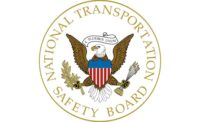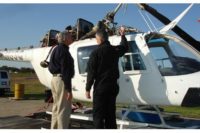A harness intended to keep helicopter passengers safely in place was the cause of the aircraft losing power and ending up in New York City’s East River, in which all five passengers drowned. The pilot sustained minor injuries.
That’s the conclusion of the National Transportation Safety Board’s (NTSB) investigation into the March 11, 2018 incident involving a doors-off sightseeing helicopter.
According to the NTSB’s report, one of the harnesses accidentally caught on and activated the floor-mounted engine fuel shutoff lever and resulted in the in-flight loss of engine power and the subsequent ditching.
A 30-minute flight
The FlyNYON-branded aerial photography flight was operated by Liberty Helicopters Inc. (Liberty), per a contractual agreement with NYONair. Visual flight rules (VFR) weather conditions prevailed, and no flight plan was filed for the intended 30-minute local flight, which departed from Helo Kearny Heliport, Kearny, New Jersey, about 1850.
Liberty operated the accident flight as a FlyNYON-branded, doors-off helicopter flight that allowed the five passengers (one in the front seat, four in the rear seats) to take photographs of various landmarks while extending their legs outside the helicopter during portions of the flight. For the accident flight (and other FlyNYON flights that Liberty operated), Liberty configured its Airbus AS350 B2 helicopter with the two right and the front left doors removed and the left sliding door locked open. Before departure, each passenger was fitted with a NYONair-provided harness/tether system that NYONair developed with the intent to prevent passengers from falling out of the helicopter. The harness/tether system used on the accident flight consisted of a full-body, workplace fall-protection harness that was secured (with a locking carabiner) to a tether, the other end of which was secured (with another locking carabiner) to an anchor point in the cabin. Each passenger also wore the helicopter’s installed, Federal Aviation Administration (FAA)-approved restraints. The pilot (who was seated in the front right seat) wore only an installed, FAA-approved restraint.
Freedom of movement allowed
After the flight departed, it traveled past various scenic landmarks. Consistent with the standard operating procedures (SOPs) used for FlyNYON flights, the passengers were allowed (when instructed by the pilot) to position themselves to extend their legs outside the helicopter. The two passengers who had been seated in the rear inboard seats removed their installed, FAA-approved restraints and sat on the cabin floor, wearing their harness/tether systems. The passengers seated in the outboard seats were allowed to rotate outboard in their seats. To enable such freedom of movement, the SOPs allowed the passengers to wear their installed, FAA-approved restraint with the lap belt adjusted loosely and the shoulder harness routed under the arm.
A review of radar data and onboard video showed that, when the flight was proceeding northwest over Manhattan toward Central Park at an altitude of 1,900 ft mean sea level, the front passenger, who was facing outboard in his seat with his legs outside the helicopter, leaned back several times to take photographs using a smartphone. The onboard video showed that, each time he leaned back, the tail of the tether attached to the back of his harness hung down loosely near the helicopter’s floor-mounted controls. At one point, when he pulled himself up to adjust his seating position, the tail of his tether remained taut but appeared to pop upward. Two seconds later, the helicopter’s engine sounds decreased, and the helicopter began to descend.
Pilot was able to escape, but...
As the pilot performed the emergency procedures to perform an autorotation and address the apparent loss of engine power, he noticed that the fuel shutoff lever (FSOL) was in the shutoff position and that it had been inadvertently moved to that position by the tail of the front passenger’s tether, which had become caught on it.
Although the pilot pushed the FSOL down to restore fuel flow to the engine and attempted to relight the engine, the helicopter was too low to allow engine power to be restored in time to prevent the emergency landing. The pilot pulled the activation handle to deploy the helicopter’s emergency flotation system, and he ditched the helicopter on the East River. However, the helicopter’s floats did not fully inflate, and the helicopter rolled right in the water and became fully inverted and submerged about 11 seconds after it touched down.
The pilot was able to release his installed, FAA-approved restraint after he was under water and successfully egress from the helicopter; however, none of the passengers were able to egress, and they all drowned.
Probable cause
The NTSB determines the probable cause of this accident was Liberty Helicopters Inc.’s use of a NYONair-provided passenger harness/tether system, which caught on and activated the floor-mounted engine fuel shutoff lever and resulted in the in-flight loss of engine power and the subsequent ditching. Contributing to this accident were (1) Liberty’s and NYONair’s deficient safety management, which did not adequately mitigate foreseeable risks associated with the harness/tether system interfering with the floor-mounted controls and hindering passenger egress; (2) Liberty allowing NYONair to influence the operational control of Liberty’s FlyNYON flights; and (3) the Federal Aviation Administration’s inadequate oversight of Title 14 Code of Federal Regulations Part 91 revenue passenger-carrying operations. Contributing to the severity of the accident were (1) the rapid capsizing of the helicopter due to partial inflation of the emergency flotation system and (2) Liberty and NYONair’s use of the harness/tether system that hindered passenger egress.


